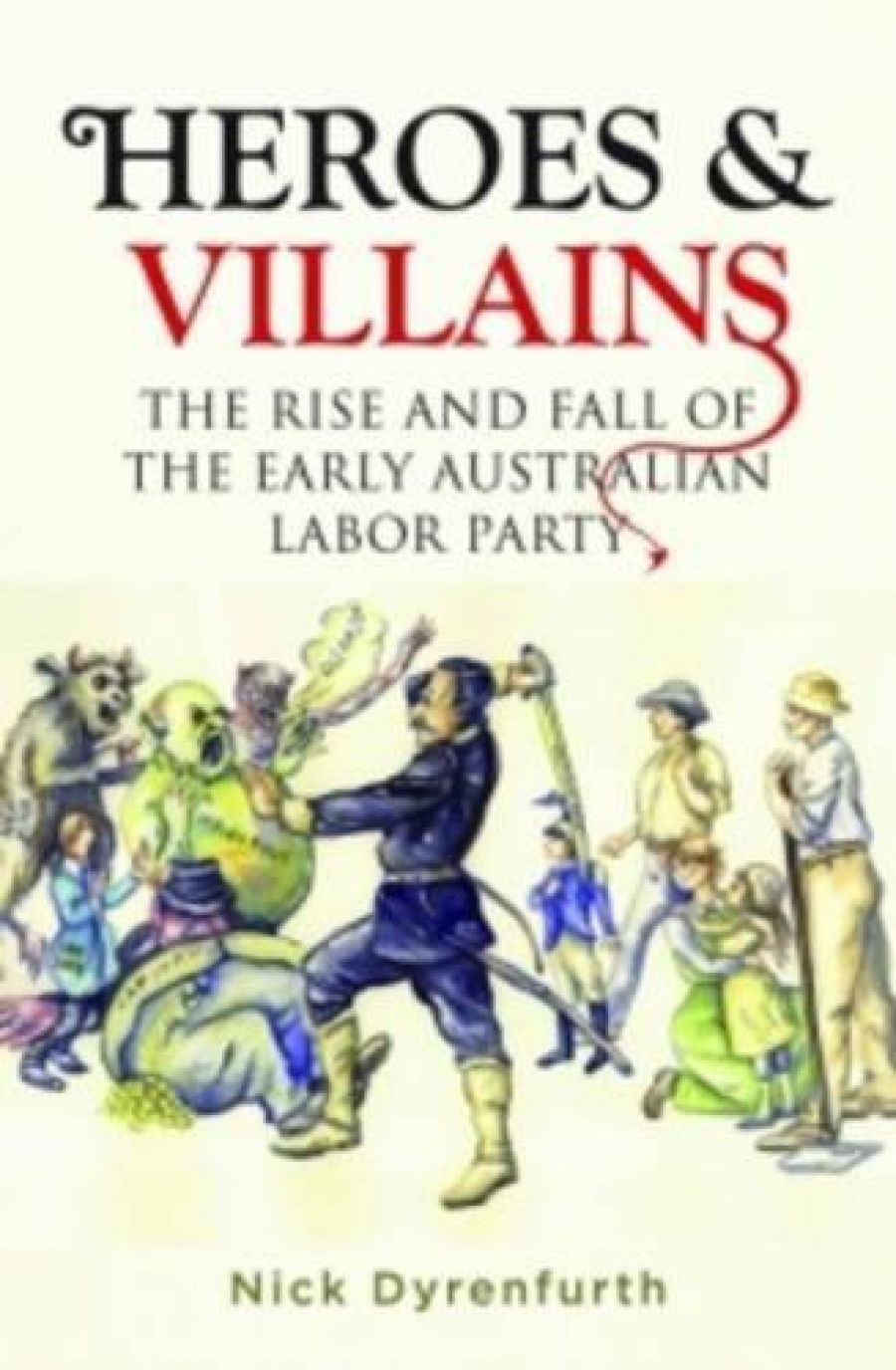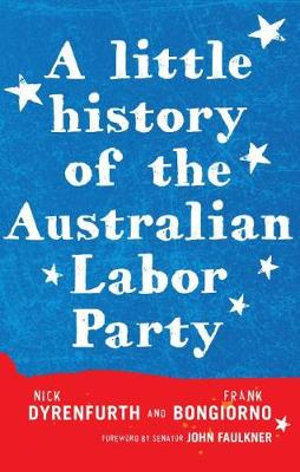
- Free Article: No
- Contents Category: Politics
- Review Article: Yes
- Online Only: No
- Custom Highlight Text:
The heroes and villains in Nick Dyrenfurth’s account of the early Labor Party are the cartoon figures in the labour press that he uses to explore its political rhetoric. The heroes are sturdy working men, sometimes in bush garb, sometimes industrial labourers. The villains take various forms: serpents, harpies, bloodsucking insects, menacing aliens, but above all the Fat Man, the swollen, grotesque embodiment of capitalist greed. Dyrenfurth observes that Mr Fat is a far more ubiquitous device in Australian radical iconography than its counterparts elsewhere. British cartoons used a variety of villains: aristocratic loafers, rapacious landlords, ruthless sweaters, mendacious press barons. Those in the United States were less likely to personify capitalism with a generic capitalist villain than to depict combines and trusts.
- Book 1 Title: Heroes & Villains
- Book 1 Subtitle: The Rise and Fall of the Early Australian Labor Party
- Book 1 Biblio: Australian Scholarly Publishing, $44 pb, 281 pp
- Book 2 Title: A Little History of the Australian Labor Party
- Book 2 Biblio: New South, $24.95 pb, 217 pp, 9781742232843
- Book 2 Cover Small (400 x 600):

- Book 2 Cover (800 x 1200):

- Book 2 Cover Path (no longer required): images/1_SocialMedia/2021/September_2021/META/a-little-history-of-the-australian-labor-party.jpg
Dyrenfurth suggests that the Labor Party grew rapidly after its formation in the early 1890s by deploying this imagery to mobilise voters around a program that associated the rights of labour with the interests of all wealth producers. Within the new Commonwealth, it cultivated a national sentiment that made Labor the defender of racial purity and the champion of Australian values. The party won office in its own right in 1910 by rejecting industrial militancy and resisting doctrinaire socialism. It was only after the wartime split over conscription that Labor lurched to the left. Shorn of its moderates, it became an ‘electorally unattractive working-class entity’ and an ‘electoral basket case’. The radicals are cast as the villains in Dyrenfurth’s version of labour history, and the sensible labourists as the heroes.
These political coordinates are well established in labour historiography. There is an extensive literature on the formation of the Labor Party, the way that it built up its membership from affiliated unions and local branches, and created an organisational structure for determining policy that bound the elected representatives. We know how the parliamentary leaders resisted the imposition of doctrinaire policy that would restrict its electoral appeal as they reached out from the party’s working-class base to a broader constituency. The novelty of this account is the way it presents this pragmatic labourism as a fully articulated and rhetorically powerful doctrine.
It is here that the figures of Mr Fat and the white male worker were set in motion. The labour movement emerged from an earlier alliance with local producers, farmers, and manufacturers who constituted the productive classes; it inherited an advanced liberal ideology that championed the people against the vested interests. The founders of the Labor Party redefined this polarity to make the worker emblematic of the people. In national politics they laid claim to the legislative program designed to protect living standards, and cast themselves as the true nation-builders. They appropriated the White Australia Policy, championed national defence, constantly juxtaposing manly virtue against the unpatriotic malevolence of the degenerate Mr Fat.
Dyrenfurth uses a rich selection of cartoons to illustrate this strategy, though his attention to their visual imagery is uneven. He tells us something of the principal cartoonists, but little of the circumstances of their production, the reach of the labour press in which they appeared, or the technology and economics of their production. His interpretation of their purpose is handicapped by the anachronistic framework of analysis he employs. Discussing William Guthrie Spence’s grandiloquently named memoir, Australia’s Awakening: Thirty Years in the Life of an Australian Agitator (1909), which undoubtedly exemplifies the identification of Labor with national fulfilment, he says that ‘if Spence had been writing today he might have described Labor’s modus operandi by adapting the central maxim of modern social democratic third-wayers: “It’s the narrative, stupid!”’ On the contrary, if Spence were able to see how the practitioners of the black art purloined and used this literary term so vacuously, he would have wondered what happened to his forty years of labour activism.
There are constant references to narrative, along with cultural spaces, interventions, circuit-breakers, rhetorical toolkits, dominant tropes, and political capital. Such embellishments only draw attention to the quite different circumstances and lexicon of early twentieth-century politics. The author’s own imagery is sometimes insecure. He suggests that Labor’s deployment of Mr Fat ‘evinces the conspiratorial underbelly of Labor thought’, and that unionists ‘opened up a Pandora’s box which would eventually splinter the democratic movement’. King Pyrrhus secured a ruinous victory against the Romans at Heraclea, so it makes no sense to talk of a ‘most Pyrrhic’ one.
As these examples suggest, Dyrenfurth is too eager to draw lessons. Wanting to encourage the present-day Labor Party to ‘recognise the importance of re-crafting a compelling social democratic message’, he has to pass off the populist prejudices that constituted its early labourist one. Insisting that Labor lost its way when it turned to class politics, he struggles to explain how Labor held office in most of the states for most of the interwar period.
That explanation is provided in A Little History of the Australian Labor Party, which he wrote with Frank Bongiorno. I should declare an interest in this book, as I was asked to comment on a draft. I admired it then, and still do. It is a nicely judged account that distils the extensive literature on the subject into an accessible narrative. The durability of Labor at the state level, we learn, stemmed from its immunity from allegations of disloyalty and a capacity to harness the functions of government that most directly affected peoples’ fortunes.
The book is written in the belief that the present discussion of how the Labor Party might rethink its structure and purpose, how it might rebuild its membership and win back disaffected voters, suffers from a lack of awareness of the past. Much of this discussion, the authors say, is carried on as if the issues are new instead of being variations on old themes. I think this underestimates the scale of the present predicament: as John Faulkner recently pointed out, Labor’s primary vote has sunk to its lowest level since 1906.
A work such as this, furthermore, is constrained by its loyalties, especially in the final chapter on the period since 1996. A brisk narrative relates the party’s ailments and repeated changes of national leadership – six of them in fifteen years – while finding attributes to praise in all the leaders. Perhaps because the conference and the caucus once maintained such strong collective control, the Labor Party had an intense loyalty to its leader, and in several cases took too long to replace those whose time was up. These days it dispatches them abruptly and then wonders why it allowed them such authority. So, too, the Little History greets each leader with an encomium and sees them off with a belated acknowledgment of their failings. A brief summary of the present predicament is followed by the statement that ‘Amid all this gloom, there are signs of Antipodean renewal’; the leadership has apparently learnt some lessons from the 2010 election and announced that the party has to renew its ‘sense of purpose’. I am always worried by calls for a sense of some quality, be it hope or confidence, resolution or purpose. I would much prefer the real thing.


Comments powered by CComment